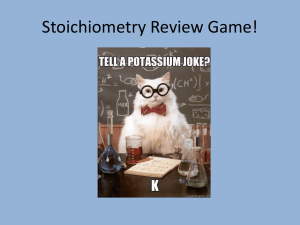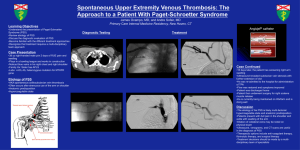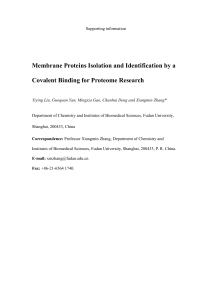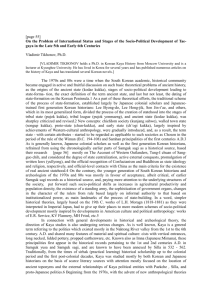Manipulating Cluster Size of Polyanion
advertisement
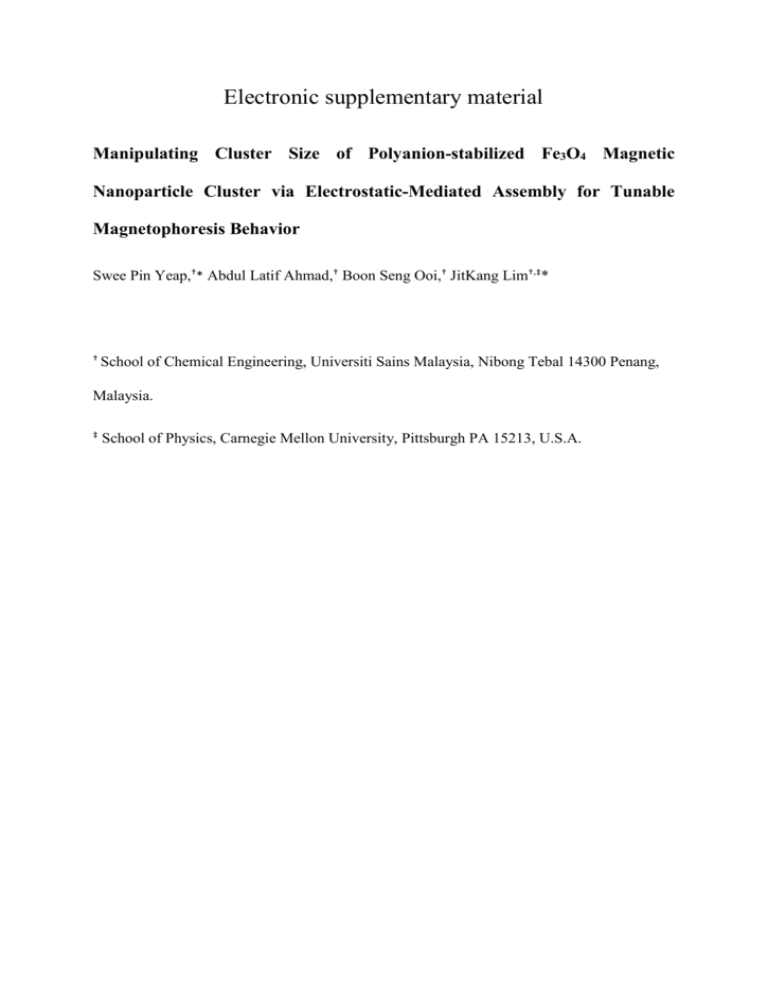
Electronic supplementary material Manipulating Cluster Size of Polyanion-stabilized Fe3O4 Magnetic Nanoparticle Cluster via Electrostatic-Mediated Assembly for Tunable Magnetophoresis Behavior Swee Pin Yeap,†* Abdul Latif Ahmad,† Boon Seng Ooi,† JitKang Lim†,‡* † School of Chemical Engineering, Universiti Sains Malaysia, Nibong Tebal 14300 Penang, Malaysia. ‡ School of Physics, Carnegie Mellon University, Pittsburgh PA 15213, U.S.A. Fig. S1. The spatial decay of (a) magnetic field strength and (b) magnetic field gradient developed by a N50-NdBFe magnet of Br = 1.45 Tesla. Fig. S2. Functionalization of bare Fe3O4 nanoparticles with PSS molecules via post-grafting approach conducted under various pH. Fig. S3. Photographs of conical tubes after use for Fe3O4/PSS mixing with (a) NaCl, (b) CaCl2, and (c) AlCl3 as the clustering agent. Photos were taken after magnetically isolating the PSS/MNCs and discarding the supernatant. Severe deposition of nanoparticles on the wall of the conical tube occurred in the case of AlCl3. In fact, this deposition was observed during the first few hours of the mixing period. Additionally, unlike samples a and b, which could be easily re-suspended in water by gentle shaking or mild sonication, the deposited particles in sample c were difficult to re-suspend. Fig. S4. Water solubility of PSS in different electrolyte solutions. Markers assigned are NaCl (●), CaCl2 (□), and AlCl3 (∆). (Note: the inserted images show the poor solubility of PSS in AlCl3, as shown by the formation of a cloudy solution). Fig. S5. (a) ATR-FTIR measurements on PSS/MNCs after one cycle of purification (W1), two cycles of purification (W2), and three cycles of purification (W3). (b) The change in the absorbance intensity of several important peaks after three cycles of purification. Note: Peaks are correspondingly assigned to the symmetric stretching of sulfonate groups (~1036 cm-1), the asymmetric stretching of sulfonate groups (~1167, ~1176 cm-1), and the in-plane vibration of aromatic C-H bonds (~1127 cm-1 and ~1008.6 cm-1). Fig. S6. The EPM values of bare Fe3O4 nanoparticles dispersed in different concentrations of NaCl and CaCl2 medium. (Note: all samples were prepared at pH ~3.5) Justification on Figure S6 Figure S6 provides information on the complex interplay between the concentration of electrolytes and the resultant electrokinetic nature of bare Fe3O4 nanoparticles. Instead of a constantly decreasing trend in EPM when the electrolyte concentration increased, we exemplified a different trend at which the EPM increased at low electrolyte concentration and decreased at higher electrolyte concentration. Such changes in EPM values are decomposed and listed as below, Bare Fe3O4 in NaCl Increase in EPM Decrease in EPM 0 mM ≤ concentration ≤ 25 mM 25 mM < concentration ≤ 300 mM Bare Fe3O4 in CaCl2 Increase in EPM Decrease in EPM 0 mM ≤ concentration ≤ 10 mM 10 mM < concentration ≤ 300 mM From a theoretical viewpoint, addition of electrolyte should reduce the magnitude of EPM. This is true for the higher range of electrolyte concentrations as shown in Figure S6. However, similar expectation was not observed for the cases within low concentration ranges (ie., ≤ 25 mM NaCl and ≤ 10 mM CaCl2). Possibly, at these concentrations, the cation exchange with the free H+ species in the system (Yukselen and Kaya 2003). Such exchange extends the electrical diffuse double layer and subsequently increased the surface charge (Yukselen and Kaya 2003; Kaya et al. 2003; Yukselen and Kaya 2011). In fact, similar observation has been reported elsewhere (Yukselen and Kaya 2003; Kaya et al. 2003; Yukselen and Kaya 2011). For instance, Kaya and coworkers reported that their kaolinite particles gained higher magnitude of surface charge in 10-4 M NaCl solution compared to that in 10-2 M NaCl solution, which is also higher than that in water only (Kaya et al. 2003). On the other hand, Potapova and coworkers reported that 3.3 mM of CaCl2 increased the positivity of the magnetite crystals at pH below its IEP and the magnitude of surface charge is higher than that in 10 mM NaCl (Potapova et al. 2011). Based upon the information presented in Figure S6 and those of literature studies, it could be concluded that the electrokinetic nature of particles is tunable by changing the solution chemistry of the dispersing medium. Nevertheless, at all concentrations, the resultant EPM of the bare Fe3O4 still gaining a net positive sign. This is crucial to promote the electrostatic-induced attachment by the negatively charged PSS molecules. Fig. S7. Changes in the average hydrodynamic cluster size of three PSS/MNCs samples with initial average hydrodynamic cluster sizes of 176.3 nm (□), 301.7 nm (×) and 459 nm (●) as a function of the cumulative energy input during the breakage test. The cumulative energy inputs were auto-generated by the system controller after 60, 150, 300, and 1800 seconds of probe sonication. For example, at 60 seconds, the cumulative energy input is 1011 Joules. Fig. S8. The EDS spectrum of (a) bare Fe3O4, (b) bare Fe3O4 treated with 300 mM CaCl2 at pH ~9.1, and (c) PSS/MNCs formed at pH ~9.1 using bare Fe3O4 pre-treated with 300 mM CaCl2. References Kaya A, Oren AH, Yukselen Y Settling behavior and zeta potential of kaolinite in aqueous media. In: Proceedings of the 13th International Offshore and Polar Engineers Conference. Honolulu, Hawaii, USA, 2003. pp 407-412 Potapova E, Yang X, Grahn M, Holmgren A, Forsmo SPE, Fredriksson A, Hedlund J (2011) The effect of calcium ions, sodium silicate and surfactant on charge and wettability of magnetite. Colloids Surf, A 386 (1-3):79-86. Yukselen Y, Kaya A (2003) Zeta potential of kaolinite in the presence of alkali, alkaline earth and hydrolyzable metal ions. Water Air Soil Poll 145 (1-4):155-168. Yukselen Y, Kaya A (2011) A study of factors affecting on the zeta potential of kaolinite and quartz powder. Environ Earth Sci 62:697-705.

